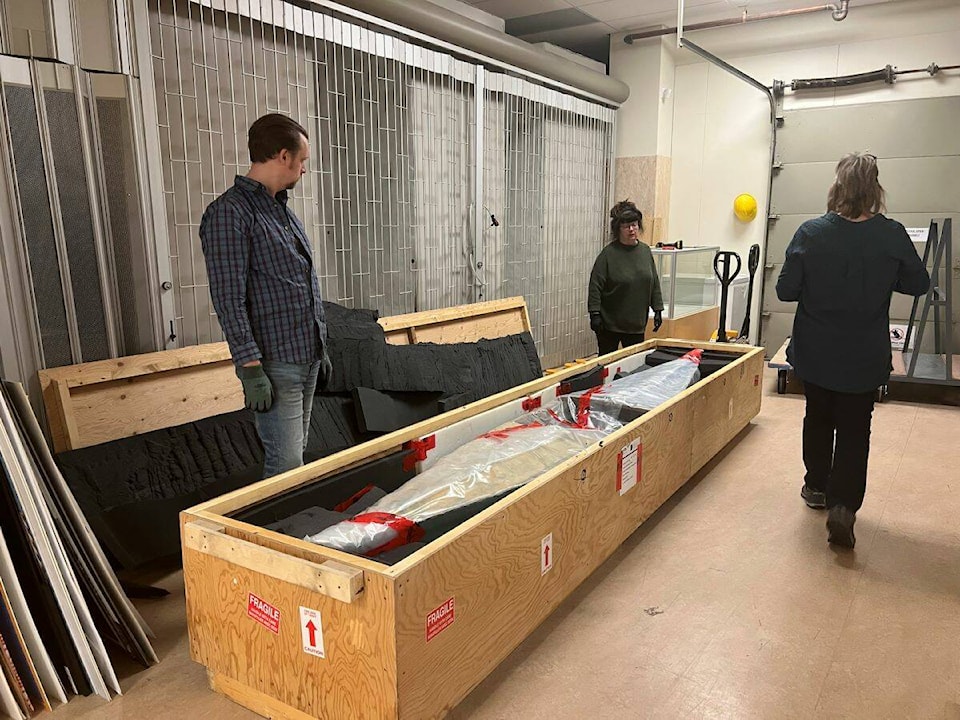A kayak donation to the Prince of Wales Northern Heritage Centre (PWNHC) was unveiled earlier this week.
The 20 ft. x 2 ft. kayak made of wood and canvas was made by Angagaq (Bertram Pokiak) around 1960 in Tuktoyaktuk. As the story goes, Angagaq used the kayak to retrieve seals shot from the edge of the sea ice.
Susan Irving, the museumSA����Ӱ�Ӵ�ý�s manager of collections, discussed the process of acquiring the kayak.
She said that the kayak took several years to acquire due to logistical challenges and cancellations caused by Covid-19. However, with the help of a local carpenter who made a custom crate and other people who assisted in transporting the kayak, it eventually arrived at the museum toward the end of last year.
Inuk (Brendalynn Trennert), a granddaughter of Angagaq, said that the family is proud of their grandfatherSA����Ӱ�Ӵ�ý�s work and is happy to see it preserved in the museum for future generations to learn about their culture and heritage.
SA����Ӱ�Ӵ�ý�To hear (uncle) Charles Pokiak talk about the kayak that grandpa built for him and for him to use it is really special,SA����Ӱ�Ӵ�ý� said Trennert. SA����Ӱ�Ӵ�ý�If it wasnSA����Ӱ�Ӵ�ý�t brought here to a place where everybody is qualified and educated to preserve this artifact as best as possible, I wouldnSA����Ӱ�Ӵ�ý�t have had a chance to see this.SA����Ӱ�Ӵ�ý�
She also said that because of the lack of trees in the Arctic region, getting the right material was really a challenge.
She explained that in the past, people used whatever materials were avaliable to them to make things SA����Ӱ�Ӵ�ý� in this case, her grandfather had to use willows and canvas to make the kayak.
Trennert believes that this could be a perfect example to tell the history of Indigenous people in Canada and how they lived on this land.
She was also really proud of her ancestorSA����Ӱ�Ӵ�ý�s skills that to use certain tools to make things that sustained life.
SA����Ӱ�Ӵ�ý�We wouldnSA����Ӱ�Ӵ�ý�t be here if the kayak wasnSA����Ӱ�Ӵ�ý�t used for getting food (and) bringing food home,SA����Ӱ�Ӵ�ý� said Trennert. SA����Ӱ�Ӵ�ý�So many things like clothing that you wore SA����Ӱ�Ӵ�ý� your stitches had to be waterproof, windproof and warm, If my ancestors didnSA����Ӱ�Ӵ�ý�t have that, I wouldnSA����Ӱ�Ӵ�ý�t be sitting here talking to you.SA����Ӱ�Ӵ�ý�
She expressed the importance of people making donations to the museum, especially to show young people who want to know about the past and how living in a era supported by all the newest technologies to help make things faster is so much different.
Irving said that the kayak is available for public to visit, but potential visitors need to call ahead or send an email to the museum to arrange a viewing because itSA����Ӱ�Ӵ�ý�s not part of the public gallery.



